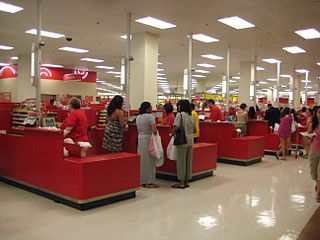Point of sale
From Wikipedia, the free encyclopedia
| The examples and perspective in this article may not represent a worldwide view of the subject. Please improve this article or discuss the issue on the talk page. |
| This article does not cite any references or sources. Please help improve this article by adding citations to reliable sources (ideally, using inline citations). Unsourced material may be challenged and removed. (April 2007) |
| It has been suggested that hospitality point of sale systems be merged into this article or section. (Discuss) |

Point of sale or point of service (POS or PoS) can mean a retail shop, a checkout counter in a shop, or the location where a transaction occurs. By synecdoche point of sale often refers to a POS terminal or more generally to the hardware and software used for checkouts – the equivalent of an electronic cash register. Point of sale systems are used in supermarkets, restaurants, hotels, stadiums, and casinos, as well as almost any type of retail establishment.
Contents |
[edit] Early software
Early electronic cash registers (ECR) were programmed in proprietary software and were very limited in function and communications capability. In August 1973 IBM announced the IBM 3650 and 3660 Store Systems that were, in essence, a mainframe computer packaged as a store controller that could control 128 IBM 3653/3663 Point of Sale Registers. This system was the first commercial use of client-server technology, peer to peer communications, Local Area Network (LAN) simultaneous backup, and remote initialization. By mid-1974, it was installed in Pathmark Stores in New Jersey and Dillards Department Stores.
Programmability allowed retailers to be more creative. In 1979 Gene Mosher's Old Canal Cafe in Syracuse, New York was using POS software written by Mosher that ran on an Apple II to take customer orders at the restaurant's front entrance and print complete preparation details in the restaurant's kitchen. In that novel context, customers would often proceed to their tables to find their food waiting for them already. This software included real time labor and food cost reports. In 1986 Mosher used the Atari ST and bundled NeoChrome paint to create and market the first graphical touchscreen POS software.
[edit] Hardware interface standardization
Vendors and retailers are working to standardize development of computerized POS systems and simplify interconnecting POS devices. Two such initiatives are OPOS and JavaPOS, both of which conform to the UnifiedPOS standard led by The National Retail Foundation.
OPOS, short for OLE for POS, was the first commonly-adopted standard and was created by Microsoft, NCR Corporation, Epson and Fujitsu-ICL. OPOS is a COM-based interface compatible with all COM-enabled programming languages for Microsoft Windows. OPOS was first released in 1996. JavaPOS was developed by Sun Microsystems, IBM, and NCR Corporation in 1997 and first released in 1999. JavaPOS is for Java what OPOS is for Windows, and thus largely platform independent.
[edit] Communication command protocols
There are several communication protocols POS systems use to control peripherals. Among them are
- EPSON Esc/POS
- UTC Standard
- UTC Enhanced
- AEDEX
- ICD 2002
- Ultimate
- CD 5220
- DSP-800
- ADM 787/788.
There are also nearly as many proprietary protocols as there are companies making POS peripherals. EMAX, used by EMAX International, was a combination of AEDEX and IBM dumb terminal.
Most POS peripherals, such as displays and printers, support several of these command protocols in order to work with many different brands of POS terminals and computers.
[edit] Web Based POS
Web based POS can run it on any computer with an Internet connection, without software installations or updates required. It runs on secure servers in multiple data centers with real-time backups.
[edit] The restaurant industry
Hospitality point of sale systems have revolutionized the restaurant industry. This is particularly found in fast food service and sales. A number of restaurant chains employ systems which use computer networks. In the most recent technologies, registers are virtual computers, sometimes using touch screens. They will connect to a server, often referred to as a "store controller" or a "central control unit." Printers and monitors are also found on the network. Additionally, remote servers will connect to store networks and monitor sales and other store data.
The efficiency of such systems have decreased service times and increased efficiency of orders.
Currently, POS systems are manufactured and serviced by several firms; see point of sale companies category. Point of sales systems in restaurant environments operate on DOS, Windows Linux or Unix environments. They can use a variety of physical layer protocols, though Ethernet is currently the preferred system.
In the fast food industry, a number of configurations may be used to aid in the speed of operations. Registers themselves may be in front counter, drive through or walk through cashiering and ordertaking modes. Front counter registers will take and serve orders at the same terminal. Drive through registers will allow orders to be taken at one or more drive through windows and cashiered and served at another. In addition to registers, drive through and kitchen monitors may be used by store personnel to view orders. Once orders appear they may be deleted or recalled by "bump bars", small boxes which have different buttons for different uses. Drive-thru systems are often enhanced by the use of drive-thru wireless (or headset) systems which enable communications with drive-thru speakers.
[edit] Tax fraud
POS systems record sales for business and tax purposes. Illegal software dubbed "zappers" is increasingly used on them to falsify these records with a view to evading the payment of taxes.



